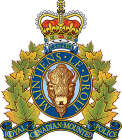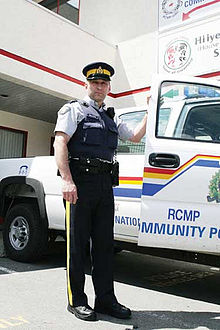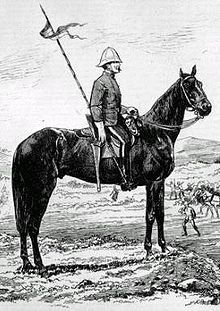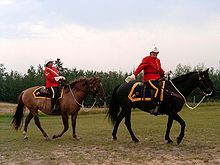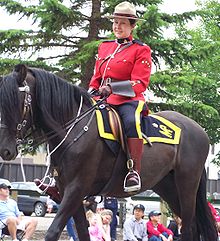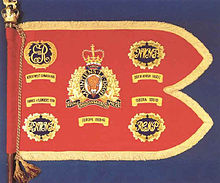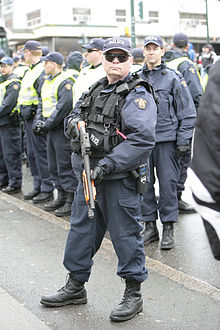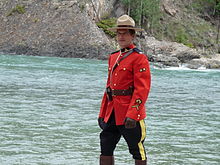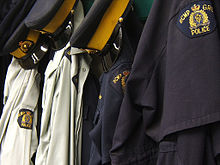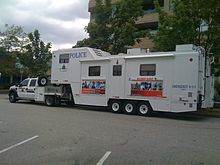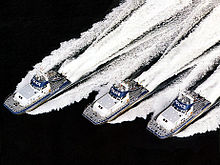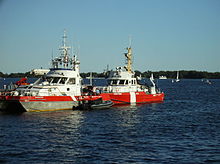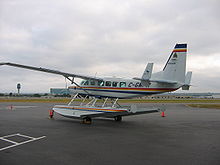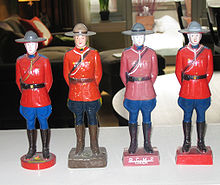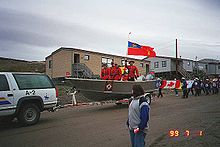- Royal Canadian Mounted Police
-
"RCMP", "Mountie", and "North West Mounted Police" redirect here. For the TV series, see R.C.M.P. (TV series). For the 1940 film, see North West Mounted Police (film).
Royal Canadian Mounted Police
Gendarmerie royale du Canada
The MountiesAbbreviation RCMP/GRC Heraldic badge of the RCMP Motto Maintiens le droit Defending the law[1][2] Agency overview Formed 1920 Preceding agencies - Royal Northwest Mounted Police (RNWMP) (1873, May 23)
- Dominion Police (1868)
Employees 29,292 Legal personality Governmental: Government agency Jurisdictional structure Federal agency Canada Constituting instruments - Royal Canadian Mounted Police Act
- Provincial Police Acts
General nature Operational structure Sworn members 19,414 (Sept. 2010)[3]-
- Commissioner 1
- Deputy Commissioner 7
- Assistant Commissioner 26
- Chief Superintendent 60
- Superintendent 185
- Inspector 446
- Corps Sergeant Major 1
- Sergeants Major 7
- Staff Sergeants Major 17
- Staff Sergeants 950
- Sergeants 2,153
- Corporals 3,653
- Constables 11,834
- Special Constables 74
Unsworn members 9,878 (Sept. 2010)[3]-
- Civilian Members 3,733
- Public Servants 6,145
Elected officer responsible The Honourable Vic Toews, Minister of Public Safety Agency executive Bob Paulson, Commissioner Parent agency Public Safety Canada Divisions 15- A Division: National Capital
- B Division: Newfoundland and Labrador
- C Division: Quebec
- D Division: Manitoba
- E Division: British Columbia
- F Division: Saskatchewan
- G Division: Northwest Territories
- H Division: Nova Scotia
- J Division: New Brunswick
- K Division: Alberta
- L Division: Prince Edward Island
- M Division: Yukon
- O Division: Ontario
- T Division: Depot
- V Division: Nunavut
Facilities Planes 34 Helicopters 10 Notables Significant incidents Awards Website www.rcmp-grc.ca Footnotes While a federal agency, the RCMP also provides direct policing to dependant territories. See Responsibilities The Royal Canadian Mounted Police (RCMP) (French: Gendarmerie royale du Canada (GRC), literally ‘Royal Gendarmerie of Canada’; colloquially known as The Mounties, and internally as ‘The Force’) is the national police force of Canada, and one of the most recognized of its kind in the world. It is unique in the world as a national, federal, provincial and municipal policing body. The RCMP provides policing services to all of Canada at a federal level, and also on a contract basis to the three territories, eight of Canada's provinces (the RCMP does not provide provincial or municipal policing in either Ontario or Quebec), more than 190 municipalities, 184 aboriginal communities, and three international airports.[4]
The RCMP was formed in 1920 by the merger of the Royal Northwest Mounted Police (RNWMP, founded 1873) with the Dominion Police (founded 1868). The former was originally named the North-West Mounted Police (NWMP), and was given the Royal prefix by King Edward VII in 1904. Much of the present-day organization's symbolism has been inherited from its days as the NWMP, including the distinctive Red Serge uniform, paramilitary heritage, and mythos as a frontier force. The RCMP/GRC wording is specifically protected under the Trade-marks Act.[5]
As the national police force of Canada, the Royal Canadian Mounted Police is primarily responsible for enforcing federal laws throughout Canada, while general law and order including the enforcement of the Criminal Code and applicable provincial legislation is constitutionally the responsibility of the provinces and territories. This responsibility is sometimes further delegated to municipalities which can form their own municipal police departments. This is common in the largest cities.
The two most populous provinces, Ontario and Quebec, maintain their own provincial forces; the Ontario Provincial Police and Sûreté du Québec. The other eight provinces, however, have chosen to contract most or all of their provincial policing responsibilities to the RCMP. Under these contracts the RCMP provides front-line policing in those provinces under the direction of the provincial governments in regard to provincial and municipal law enforcement. When Newfoundland joined the confederation in 1949, the RCMP entered the province and absorbed the then Newfoundland Rangers and took over responsibilities in that area. Today the Royal Newfoundland Constabulary has reclaimed some of that province to their jurisdiction. In the three territories, the RCMP serves as the sole territorial police force. Additionally, many municipalities throughout Canada contract the RCMP to serve as their police force. The RCMP consequently provides policing services at the federal, provincial and municipal level.
The RCMP is responsible for an unusually large breadth of duties. Under their federal mandate, the RCMP provides policing throughout Canada, including Ontario and Quebec (albeit under smaller scales there). Federal operations include: enforcing federal laws including commercial crime, counterfeiting, drug trafficking, border integrity, organized crime and other related matters; providing counter-terrorism and domestic security; providing protection services for the Monarch, Governor General, Prime Minister, their families and residences, and other ministers of the Crown, visiting dignitaries, and diplomatic missions; and participating in various international policing efforts. Under provincial and municipal contracts the RCMP provides front-line policing in all areas outside of Ontario and Quebec that do not have an established local police force. There are detachments located in small villages in the far north, remote First Nations reserves, and rural towns, but also larger cities such as Surrey, BC (population 394,976). In these provinces the RCMP maintains units that provide investigational support to their own detachments, as well as smaller municipal police forces, including the investigation of major crimes such as homicides, forensic identification services, police dog services, emergency response teams, explosives disposal, undercover operations, and others. Under its National Police Services branch the RCMP provides support to all police forces in Canada through the operation of support services such as the Canadian Police Information Centre, the Criminal Intelligence Service Canada, Forensic Science and Identification Services, the Canadian Firearms Program and the Canadian Police College.
The RCMP Security Service was a specialized political intelligence and counterintelligence branch with national security responsibilities, but was replaced with the Canadian Security Intelligence Service in 1984, following revelations of illegal covert operations relating to the Quebec separatist movement.[6] CSIS is not part of the RCMP, but is its own entity.
Duties, conduct and operational and reporting guidelines are very specifically laid out in a detailed document known as the Commissioner's Standing Orders, or CSOs.
Contents
History
North-West Mounted Police
The RCMP has its beginnings in the North-West Mounted Police (NWMP). The police was established by an act of legislation from the Temporary North-West Council the first territorial government of the Northwest Territories.[7] The Act was approved by the Government of Canada and established on May 23, 1873, by Queen Victoria, on the advice of her Canadian Prime Minister, John A. Macdonald, with the intent of bringing law and order to, and asserting sovereignty over, the Northwest Territories. The need was particularly urgent given reports of American whiskey traders, in particular those of Fort Whoop-Up, causing trouble in the region, culminating in the Cypress Hills Massacre. The new force was initially to be called the North West Mounted Rifles, but this proposal was rejected as sounding too militaristic in nature, which Macdonald feared would antagonize both aboriginals and Americans; however, the force was organized along the lines of a cavalry regiment in the British Army, and was to wear red uniforms.
The NWMP was modelled directly on the Royal Irish Constabulary, a civilian paramilitary armed police force with both mounted and foot elements under the authority of what was then the United Kingdom of Great Britain and Ireland.[8][9] First NWMP commissioner, Colonel George Arthur French visited Ireland to learn its methods.[9]
The initial force, commanded by Commissioner French, was assembled at Fort Dufferin, Manitoba. They departed on July 8, 1874, on a march to what is now Alberta.
The group comprised 22 officers, 287 men – called constables and sub-constables – 310 horses, 67 wagons, 114 ox-carts, 18 yoke of oxen, 50 cows and 40 calves.[10] A pictorial account of the journey was recorded in the diary of Henri Julien, an artist from the Canadian Illustrated News, who accompanied the expedition.[11]
Their destination was Fort Whoop-Up, a notorious whiskey trading post located at the junction of the Belly and Oldman Rivers. Upon arrival at Whoop-Up and finding it abandoned the troop continued a few miles west and established headquarters on an island in the Oldman, naming it Fort MacLeod.
Historians have theorized that failure of the 1874 March West would not have completely ended the Canadian federal government's vision of settling the country's western plains, but could have delayed it for many years.[citation needed] It could also have encouraged the Canadian Pacific Railway to seek a more northerly route for its transcontinental railway that went through the well-mapped and partially settled valley of the North Saskatchewan River, touching on Prince Albert, Battleford and Edmonton, and through the Yellowhead Pass, as originally proposed by Sandford Fleming.[12] This would have offered no economic justification for the existence of cities like Brandon, Regina, Moose Jaw, Swift Current, Medicine Hat, and Calgary, which could, in turn, have tempted American expansionists to make a play for the flat, empty southern regions of the Canadian prairies.
The NWMP's early activities included containing the whiskey trade and enforcing agreements with the First Nations peoples; to that end, the commanding officer of the force arranged to be sworn in as a justice of the peace, which allowed for magisterial authority within the Mounties' jurisdiction. In the early years, the force's dedication to enforcing the law on behalf of the First Nations peoples impressed the latter enough to encourage good relations between them and the Crown. In the summer of 1876, Sitting Bull and thousands of Sioux fled from the US Army towards what is now southern Saskatchewan, and James Morrow Walsh of the NWMP was charged with maintaining control in the large Sioux settlement at Wood Mountain. Walsh and Sitting Bull became good friends, and the peace at Wood Mountain was maintained. In 1885, the NWMP helped to quell the North-West Rebellion led by Louis Riel. They suffered particularly heavy losses during the Battle of Duck Lake, but saw little other active combat.
Klondike Gold Rush
 North-West Mounted Police officers, Yukon, 1900
North-West Mounted Police officers, Yukon, 1900
In 1896, concerned about the influence of American miners and the ongoing liquor trade, the Canadian government sent inspector Charles Constantine to report on conditions in the Yukon. Constantine correctly forecast a coming gold rush and urgently recommended sending a force to secure Canadian sovereignty there and collect customs duties; he returned the following year with a force of 20 men. Under the command of Constantine, and his successor in 1898, the more famous Sam Steele, the NWMP distinguished itself during the Klondike Gold Rush, which started in 1896, making it one of the most peaceful and orderly such affairs in history.[citation needed] The NWMP not only enforced criminal law, but also collected customs duties, established a number of rules such as the "ton of goods" requirement for prospectors to enter the Yukon to avoid another famine, mandatory boat inspections for those wanting to travel the Yukon River, and created the Blue Ticket used to expel undesirables from the Klondike. The Mounties did tolerate certain illegal activities, such as gambling and prostitution, and the force did not succeed in its attempt to establish order and Canadian sovereignty in Skagway, Alaska, at the head of the Lynn Canal, instead creating the customs post at the summit of the Chilkoot Pass. At that same time, the dissolution of the NWMP was being discussed in the House of Commons, but the gold rush prospectors were so impressed by the conduct of the Mounted Police that the force became world famous and its continuation was ensured.
Evolution of the force
The North-West Mounted Police's jurisdiction was extended northward to the Yukon Territory in 1895 and then again in 1903 to the Arctic coast, with the establishment of a post at Cape Fullerton. In June 1904, the prefix "Royal" was conferred on the NWMP by King Edward VII.[13] Jurisdiction was extended to the new provinces of Alberta and Saskatchewan in 1905, and to Manitoba's new annexation in 1912. During World War I the RNWMP was responsible for "border patrols, surveillance of enemy aliens, and enforcement of national security regulations".[13] In 1917, provincial policing contracts were terminated, and the RNWMP was responsible only for federal policing in Alberta, Saskatchewan, and the Territories. Come 1918, however, enforcement was once again extended to all four Western Provinces (British Columbia, Alberta, Saskatchewan, and Manitoba).[13] A squadron was deployed to Vladivostok, Russia in late 1918 as part of the Canadian Siberian Expeditionary Force. Six months later, in June 1919, the RNWMP was called in to repress the general strike in Manitoba's capital, Winnipeg, where officers fired into a crowd of strikers, killing two and causing injury to thirty others. Another strike of that scale was never seen again, but clashes between the RNWMP and strikers continued; Mounties killed three strikers in 1931, when striking coal miners from Bienfait, Saskatchewan demonstrated in nearby Estevan. These incidents did not help the image of the RNWMP, which, since the end of First World War, was being looked at as an outdated institution, more suited to the 19th century frontier than with an industrialising 20th century Canada.
Aylesworth Perry served as Commissioner of the North-West Mounted Police from 1900 to 1922. It was in this period that the force was faced, again, with dissolution, but was saved in 1920 when it merged with the Dominion Police and was renamed as the "Royal Canadian Mounted Police". The new organization was charged with federal law enforcement in all the provinces and territories, and immediately set about establishing its modern role as protector of Canadian national security, as well as assuming responsibility for national counterintelligence.
As part of its national security and intelligence functions, the RCMP was responsible for infiltrating any ethnic or political groups that were considered to be dangerous to Canada's existing order. This included the Communist Party of Canada, but also a variety of minority cultural and nationalist groups. The force was also deeply involved in immigration matters, and especially deportations of suspected radicals. They were especially concerned with Ukrainian groups, both nationalist and socialist.[14] The Chinese community was also targeted because the perceived link to opium dens. Historians estimate that fully two per cent of the Chinese community was deported between 1923 and 1932, largely under the provisions of the Opium and Narcotics Drugs Act (ONDA).[15] Besides the RCMP's new responsibilities in intelligence, drugs enforcement, and immigration, the force also provided assistance to numerous other federal agencies, such as enforcing the residential school system for First Nations' children.
In 1935, the RCMP, collaborating with the Regina Police Service, crushed the On-to-Ottawa Trek by sparking the Regina Riot, in which one city police officer and one protester were killed. The Trek, which had been organized to call attention to the abysmal conditions in the relief camps, therefore failed to reach Ottawa, but nevertheless had profound political reverberations.
The RCMP employed special constables to assist with strikebreaking in the interwar period. For a brief period in the late 1930s, a volunteer militia group, the Legion of Frontiersmen were affiliated with the RCMP. Many members of the RCMP belonged to this organization, which was prepared to serve as an auxiliary force. In later years, special constables performed duties such as policing airports and, in certain Canadian provinces, the court houses.
In 1932, men and vessels of the Preventive Service, National Revenue, were absorbed, creating the RCMP Marine Section. The acquisition of the RCMP schooner St. Roch facilitated the first effective patrol of Canada's Arctic territory. It was the first vessel to navigate the Northwest Passage from west to east (1940–42), the first to navigate the Passage in one season (from Halifax to Vancouver in 1944), the first to sail either way through the Passage in one season, and the first to circumnavigate North America (1950).[16]
Counterintelligence work was moved from the RCMP's Criminal Investigation Department to a specialized intelligence branch, the RCMP Security Service, in 1939.
Post-war
April 1, 1949, Newfoundland joined in full confederation with Canada and the Newfoundland Rangers amalgamated with the RCMP.
Following the 1945 defection of Soviet cipher clerk, Igor Gouzenko and his revelations of espionage, the RCMP Security Service implemented measures to screen out “subversive” elements from the public sector.[17]
Queen Elizabeth II approved in Regina, Saskatchewan on July 4, 1973 a new badge for the RCMP, in recognition of which the force presented the sovereign with a tapestry rendering of the new design.[18]
In the late 1970s, revelations surfaced that the RCMP Security Service force had in the course of their intelligence duties engaged in crimes such as burning a barn and stealing documents from the separatist Parti Québécois, and other abuses. This led to the Royal Commission of Inquiry into Certain Activities of the RCMP, better known as the "McDonald Commission," named for the presiding judge, Mr Justice David Cargill McDonald. The Commission recommended that the force's intelligences duties be removed in favor of the creation of a separate intelligence agency, the Canadian Security Intelligence Service (CSIS).
Modern era
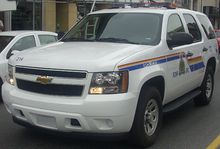 Chevrolet Tahoe RCMP SUV in Ottawa.
Chevrolet Tahoe RCMP SUV in Ottawa.
In 1993, the Special Emergency Response Team (SERT), were transferred to the Canadian Forces, creating a new unit called Joint Task Force Two (JTF2). JTF2 inherited some equipment and SERT's former training base near Ottawa.
The Royal Canadian Mounted Police have been involved in training and logistically supporting the Haitian National Police since 1994, a controversial matter in Canada considering allegations of widespread human rights violations on the part of the HNP. Some Canadian activist groups have called for an end to the RCMP training.[19] The RCMP has also provided training overseas in Iraq and other peace-keeping missions.
The suspected driver of the reconnaissance vehicle involved in the Khobar Towers bombing fled to Canada where he was arrested by the Royal Canadian Mounted Police in the winter of 1997, and was extradited to the United States.
Main article: Mayerthorpe IncidentOn March 3, 2005, four RCMP officers were fatally shot during an operation to recover stolen property and investigate a possible marijuana grow-op and serve an arrest warrant just outside of Mayerthrope, Alberta. Shooter James Roszko, 46, then killed himself. It was the single worst multiple killing of RCMP officers since the Northwest Rebellion. One of the four Mounties killed had been on the job for only 17 days. The victims were:
- Const. Lionide (Leo) Nicholas Johnston, 34 – Mayerthorpe Detachment
- Const. Anthony Fitzgerald Orion Gordon, 28 – Whitecourt Town Detachment General Policing and Highway Patrol
- Const. Brock Warren Myrol, 29 – Mayerthorpe Detachment
- Const. Peter Christopher Schiemann, 25 – Mayerthorpe Detachment General Policing and Highway Patrol[20]
On October 29, 2005, constable Paul Koester shot and killed Ian Bush while he was in custody. An internal investigation resulted in no action being taken against the constable,[citation needed] and, as a result, a public inquest was commissioned. The inquest recommended that the RCMP refrain from carrying out internal investigations with regard to fatal incidents involving the RCMP and the public.[citation needed]
Main article: Spiritwood IncidentOn July 7, 2006, two RCMP officers were shot to death near Mildred, Saskatchewan. The killer, Curtis Dagenais, 41, was missing until July 18, when he turned himself in. The victims were:
- Const. Robin Cameron, 29: Spiritwood Detachment
- Const. Marc Bourdages, 26: Spiritwood Detachment
Dagenais was subsequently convicted of two counts of murder and one count of attempted murder of a third Mountie who arrived shortly after the initial firefight.
In 2006, the United States Coast Guard's Ninth District and the RCMP began a program called "Shiprider," in which 12 Mounties from the RCMP detachment at Windsor and 16 Coast Guard boarding officers from stations in Michigan ride in each other's vessels. The intent is to allow for seamless enforcement of the international border. (PA1 John Masson, "Territorial Teamwork," Coast Guard Magazine 2/2006, pp. 26–27).
On December 6, 2006, RCMP Commissioner Giuliano Zaccardelli resigned one day after informing the House of Commons Standing Committee on Public Safety and National Security that his earlier testimony about the Maher Arar case was inaccurate. The RCMP had improperly given information to the US that resulted in Arar, a Canadian returning to Montreal via the US, being sent to Syria where he was imprisoned for 10 months and tortured into signing a false confession of links to terrorists.[citation needed] Earlier, on September 28, 2006, and before the same Commons committee, Commissioner Zaccardelli had issued a carefully worded public apology to Arar and his family:
Mr. Arar, I wish to take this opportunity to express publicly to you and to your wife and to your children how truly sorry I am for whatever part the actions of the RCMP may have contributed to the terrible injustices that you experienced and the pain that you and your family endured.[21]
On January 26, 2007, after months of negotiations between the Canadian government and Arar's Canadian legal counsel, Prime Minister Stephen Harper issued a formal apology "for any role Canadian officials may have played in what happened to Mr. Arar, Monia Mazigh and their family in 2002 and 2003"[citation needed] and announced that Arar would receive $10.5 million settlement for his ordeal and an additional $1 million for legal costs.
See also: Maher ArarOn October 6, 2007, Constable Christopher John Worden of Hay River Detachment, Northwest Territories was shot and killed in Hay River while on duty in that community. A nationwide arrest warrant was issued for Emrah Bulatci. Bulatci was apprehended on October 12 in Edmonton, Alberta.
On October 14, 2007, Robert Dziekański, an emigrant from Poland, died at Vancouver International Airport. Dziekański had failed to clear Customs and after eight hours of loitering became agitated, perhaps because he spoke no English and therefore was unable to ask for assistance. Four RCMP officers were summoned after he threw a computer and a small table. During his arrest, he was Tasered at least twice within 25 seconds of the officers' arrival. After dropping to the floor, he was held down and handcuffed by the officers. Paramedics pronounced him dead at the scene. The incident was videotaped and eventually released to the public, resulting in outrage over the RCMP's handling of the unarmed man. The Dziekanski confrontation has provoked considerable debate about the use of Tasers in policing.
On November 6, 2007, Constable Doug Scott, 20, was killed in Kimmirut, Nunavut when responding to a report of a possible impaired driver. He had been with the service for only six months.[22]
In 2007, the RCMP was named Newsmaker of the Year by the Canadian Press.[23]
History of the RCMP uniform
The RCMP are famous for their distinctive Red Serge, referred to as "Review Order" (of dress uniform), consisting of: high collared scarlet tunic, midnight blue breeches with yellow leg strip, Sam Browne belt with shoulder cross strap and white sidearm lanyard, oxblood riding boots (possibly with spurs), brown felt Campaign hat (wide, flat brimmed) with the characteristic "Montana crease", and brown gloves (with brown leather gauntlets for riders). Review Order is worn by the mounted troop performing the Musical Ride, an equestrian drill in which mounted members demonstrate their riding skills and handling of the cavalry lance. On normal duties, the RCMP uses standard police methods, equipment, and uniforms. Horses are still used for such ceremonial operations as escorting the Governor General's open landau to the Opening of Parliament.
The Red Serge tunic that identified initially the NWMP, and later the RNWMP and RCMP, is of the standard British military pattern. The NWMP was originally kitted out from militia stores, resulting initially in several different styles of tunic, although the style later became standardized. This style was used both to emphasize the British nature of the force and to differentiate it from the blue American military uniforms. The blue shoulder epaulets were added in the 1920s, long after King Edward VII granted the Force "Royal" status for its service in the Second Boer War, replacing gold-trimmed scarlet straps from the earlier uniforms. Currently, RCMP personnel under the rank of inspector wear blue "gorget" patches on the collar, while officers from inspector to commissioner have solid blue collars, along with blue pointed-sleeve cuffs.
Initially the NWMP wore buff breeches. Later dark blue breeches with yellow-gold strapping (stripes) were adopted. Members of the NWMP were known to exchange kit with U.S. cavalry units along the border and it is suggested that this was the initial source for the breeches; however, blue breeches were considered early on, although with a white strap. Dark blue with yellow-gold strapping is another British cavalry tradition.
The wide, flat-brimmed Stetson hat was not adopted officially until about 1904. Although the NWMP contingent at Queen Victoria's Diamond Jubilee wore the Stetson, it was an unofficial item of dress. The primary official summer headdress at the time was the white British foreign service helmet, also known as a pith helmet. This was not particularly practical as headdress in the Canadian west, and members wore a Stetson type hat on patrol and around camp. Sam Steele is often credited with introducing the Stetson-type hat, and when he left the force to command Strathcona's Horse and took the regiment to South Africa he also adopted the Stetson for this unit. For winter a Canadian military fur wedge cap or busby was worn.
Black riding boots were later changed to the modern brown style. The original crossbelts were later changed to the brown Sam Browne type currently worn. The brown colour of the boots and belt worn with the Red Serge come from the individual member applying numerous coats of polish, often during their time in training at Depot Division.
Sidearms are standard now, but were often not worn in the early years.
The everyday uniform consists of a grey shirt with dark blue tie, dark blue trousers with gold strapping, regular patrol boots called "ankle boots," regular duty equipment, and a regular policeman's style cap. A blue Gore-Tex open-collar jacket (patrol jacket) is worn by members on operational duty, while a dark blue jacket (blue serge), is worn by sergeant majors and certain non-commissioned officers (NCOs) usually involved in aspects of recruit training or media relations. Officers wear white shirts and the patrol jacket or blue serge, depending on their duties. Short-sleeved shirts with no tie are worn in the summer by all members. Winter dress consists of a long-sleeved shirt and tie for all members and, depending on the climate of the detachment area, heavier boots, winter coats (storm coats) and a fur cap are worn.
In British Columbia the hat features a black bearskin rim belt.
In 1990, Baltej Singh Dhillon became the first Sikh officer in the RCMP to be allowed to wear a turban instead of the traditional Stetson. On March 15, the federal government, despite protests, decided that Sikhs would be permitted to wear turbans while on duty as RCMP officers.
Women in the RCMP
On May 23, 1974, RCMP Commissioner M.J. Nadon announced that the RCMP would begin to accept applications from females as regular members of the force. This opened up positions that had been previously reserved for male members. Troop 17 was the first group of 32 females who arrived at Depot in Regina on September 18 and 19, 1974, to begin training to become regular members. This first all-female troop graduated from Depot on March 3, 1975. After an initial period of being required to wear rather unflattering discrete female rig, women officers were ultimately given standard RCMP uniforms and all officers are now identically attired regardless of gender, with two exceptions. The ceremonial dress uniform, or "walking-out order", for female members currently consists of a long, blue skirt and footwear with a higher heel that slips on, commonly known as pumps. Female officers are also attired with a small black clutch purse when walking-out order is called for. The second exception in uniform is the official maternity uniform, worn when pregnant female officers are assigned to administrative duties.
In 1981 the first female was promoted to corporal and the first females served on the musical ride; in 1987 the first female served in a foreign post; in 1990 the first female was appointed detachment commander; in 1992 the first female officers were commissioned and in 1998 the first female Assistant Commissioner was appointed.
From December 15, 2006, to July 2007, Beverley Busson served as interim Commissioner of the RCMP, making her the first woman to hold the top position in the force. She was replaced by William J.S. Elliott on July 6, 2007, (Elliott was sworn in on July 16—the first civilian to lead the RCMP.)[24][25]
A regiment of dragoons
Royal Canadian Mounted Police
Gendarmerie royale du Canada
Cap badge of the Royal Canadian Mounted PoliceActive 1873–present Country Canada Type Dragoons Role Federal, National & Paramilitary Police Force Size 15 divisions Garrison/HQ RHQ—Ottawa Nickname The Mounties Motto Maintiens le droit (Defend the law)[2][26] Battle honours see Battle honours Commanders Current
commanderBob Paulson (Commissioner) Honorary Commissioner HM The Queen Honorary Deputy Commissioner HRH The Earl of Wessex[27] Insignia Shoulder flash 
Tartan RCMP Abbreviation RCMP/GRC Although the RCMP is a civilian police force, in 1921, following the service of many of its members during the First World War, King George V awarded the force the status of a regiment of dragoons, entitling it to display the battle honours it had been awarded.
Service in wartime
During the Second Boer War, members of the North-West Mounted Police were given leaves of absence to fight with the 2nd Battalion, Canadian Mounted Rifles (CMR) and Strathcona's Horse. The force raised the Canadian Mounted Rifles, mostly from NWMP members, for service in South Africa. For the CMR's distinguished service there, King Edward VII honoured the NWMP by changing the name to the Royal Northwest Mounted Police (RNWMP) on June 24, 1904.
During World War I, the Royal Northwest Mounted Police (RNWMP) conducted border patrols, surveillance of enemy aliens, and enforcement of national security regulations within Canada. However, RNWMP officers also served overseas. On August 6, 1914, a squadron of volunteers from the RNWMP was formed to serve with the Canadian Light Horse in France. In 1918, two more squadrons were raised, A Squadron for service in France and Flanders and B Squadron for service in the Canadian Siberian Expeditionary Force
In 1939, No. 1 Provost Company (RCMP), Canadian Provost Corps, was raised for service in Europe and served throughout World War II as Military Police.
Honours
The Royal Canadian Mounted Police were accorded the status of a regiment of Dragoons in 1921, with its first guidon presented in 1935.[28][29] As a regiment of dragoons, the RCMP was entitled to wear battle honours for its war service as well as carry a guidon. The RCMP mounted the King's Life Guard at Horse Guards Parade in 1937 leading up to the coronation of King George VI.
- Battle honours
- North West Canada 1885
- South Africa 1900–2
- The Great War: France and Flanders 1918, Siberia 1918–19
- The Second World War: Europe, 1939–45
- Honorary distinction
- The badge of the Canadian Provost Corps (Military Police)
(presented September 21, 1957 at a Parliament Hill ceremony for contributions to the Corps during the Second World War)
Organization
International
The RCMP International Operations Branch assists the Liaison Officer (LO) Program to deter international crime relating to Canadian criminal laws. The IOB is a section of the International Policing, which is part of the RCMP Federal and International Operations Directorate. Thirty-five Liaison Officers are placed in 25 other countries and are responsible for organizing Canadian investigations in other countries, developing and maintaining the exchange of criminal intelligence, especially national security with other countries, to provide assistance in investigations that directly affect Canada, to coordinate and assist RCMP officers on foreign business and to represent the RCMP at international meetings.[30]
Liaison Officers are located in:
- Washington, D.C.
- Miami
- Mexico City
- Bogotá
- Caracas
- Brasília
- Santo Domingo
- Port of Spain, Trinidad and Tobago
- London
- Paris
- Berlin
- The Hague
- Rome
- New Delhi
- Islamabad
- Bangkok
- Hong Kong
- Beijing
- Kuala Lumpur
- Rabat
- Pretoria
- Amman
- Dubai
National
The Royal Canadian Mounted Police is organized under the authority of the Royal Canadian Mounted Police Act. In accordance with the Act, it is headed by the Commissioner, who, under the direction of the Minister of Public Safety , has the control and management of the Force and all matters connected therewith.
The Commissioner is assisted by a Senior Deputy Commissioner who is second in command of the force. SDC primarily functions to review, consult, or advice agency matters before they are considered by the Commissioner.[31]
Under the Commissioner and Senior Deputy Commissioner, operational direction is provided by Deputy Commissioners in charge of[32]:
- Federal and International Policing
- Police Support Services
- Contract and Aboriginal Policing
- Human Resources
- East
- Ontario (“O” Division)
- National Capital Region (“A” Division)
- National Headquarters,
- Quebec (“C” Division)
- New Brunswick (“J” Division)
- Nova Scotia (“H” Division)
- Prince Edward Island (“L” Division)
- Newfoundland and Labrador (“B” Division)
- West
- British Columbia (“E” Division)
- Alberta (“K” Division)
- Saskatchewan (“F” Division)
- Manitoba (“D” Division)
- Yukon (“M” Division)
- Northwest Territories (“G” Division)
- Nunavut (“V” Division)
Regional
In 1996, the RCMP began moving towards a more regional management system under the direction of deputy commissioners. These are: Pacific, Northwestern, Central and Atlantic. This was done to allow greater grass-roots involvement in decision-making and also allows the RCMP to invest more resources into frontline services.
The RCMP divides the country into divisions for command purposes. In general, each division is coterminous with a province (for example, C Division is Quebec). The province of Ontario, however, is divided into two divisions: A Division (Ottawa) and O Division (rest of the province). There is one additional division – Depot Division, which is the RCMP Academy at Regina, Saskatchewan, and the Police Dog Service Training Centre at Bowden, Alberta. The RCMP headquarters are located in Ottawa, Ontario.
Mountie in Banff, Alberta
- A Division - National Capital Region (Ottawa, Ontario, and Gatineau, Quebec)
- B Division - Newfoundland and Labrador
- C Division - Quebec
- D Division - Manitoba
- E Division - British Columbia
- F Division - Saskatchewan
- G Division - Northwest Territories
- H Division - Nova Scotia
- J Division - New Brunswick
- K Division - Alberta
- L Division - Prince Edward Island
- M Division - Yukon
- O Division - Ontario
- V Division - Nunavut
- Depot Division at Regina, Sask. and Police Dog Service Training Centre at Innisfail, Alberta.
Personnel
The RCMP employs 28,700 men and women, including police officers, civilian members, and Public Service Employees.[3]
Actual Personnel Strength by Ranks:
- Commissioner 1
- Senior Deputy Commissioner 1
- Deputy Commissioner 6
- Assistant Commissioner 26
- Chief Superintendent 56
- Superintendent 186
- Inspector 433
- Corps Sergeant Major 1
- Sergeants Major 6
- Staff Sergeants Major 16
- Staff Sergeants 928
- Sergeants 2,090
- Corporals 3,570
- Constables 11,594
- Special Constables 74
- Civilian Members 3,607
- Public Servants 6,102
- Total 28,700
Regular members
The term "Regular Member," or RM, originates from the RCMP Act and refers to the 17,916 regular RCMP officers who are trained and sworn as Peace Officers, and include all the ranks from Constable to Commissioner. They are the police officers of the RCMP and are responsible for investigating crime and have the authority to make arrests. RMs operate in over 750 detachments, including 200 municipalities and more than 600 Aboriginal communities. RMs are normally assigned to general policing duties at an RCMP detachment for a minimum of three years. These duties will allow them to experience a broad range of assignments and experiences, such as responding to alarms, foot patrol, bicycle patrol, traffic enforcement, collecting evidence at crime scenes, testifying in court, apprehending criminals and plain clothes duties. Regular members also serve in over 150 different types of operational and administrative opportunities available within the RCMP, these include: major crime investigations, emergency response, forensic identification, international peacekeeping, bike or marine patrol, explosives disposal and police dog services. Also included are administrative roles including human resources, corporate planning, policy analysis and public affairs.
Auxiliary constables and other staff
Besides the regular RCMP officers, several types of designations exist which give them assorted powers and responsibilities over policing issues.
Currently, there are:[3]
- Auxiliary constables: 2,400
- Community Safety Officers: 16
- Reserve constables : not reported
- Special constables: 63
- Civilian members: 2,978
- Public servants: 4,626
- Auxiliary constables (A/Cst.)
- Volunteers within their own community, appointed under provincial police acts.[33] They are not police officers and can not identify themselves as such. However, they are given peace officer powers when on duty with a regular member (RM). Their duties consist mainly of assisting the RM in routine events, for eg. cordoning off crime scene areas, crowd control, participating in community policing, assistance during situations where regular members might be overwhelmed with their duties (eg. keep watch of a backseat detainee while RM interviews a victim). They are identified by the wording of 'RCMP Auxiliary' on cars, jackets and shoulder flashes.
- Community Safety Officers (CSO)
- In 2008, a new designation within the RCMP in the Province of British Columbia was created based on the UK Police Community Support Officer program. Community Safety Officers are paid, unarmed RCMP staff members with similar RCMP uniform but distinct shoulder crests with baton and pepper spray.[34][35] CSOs work with regular members in five areas: Community Safety; Crime Prevention; Traffic Support; Community Policing and Investigation Support.[36] They are peace officers but are not police officers.[37]
- Reserve constables (R/Cst.)
- A program reinstated in 2004 in British Columbia to allow for retired, regular RCMP members or other provincially trained officers to provide extra manpower when a shortage is identified.[38] R/Cst. are appointed under Section 11 of the Royal Canadian Mounted Police Act as paid part time, armed officers with the same powers as regular members.[39] However, they are not allowed to carry force-issued sidearms and use of force options unless they are called upon to duty.[38] They generally carry out community policing roles but may also be called upon if an emergency occurs.[38][40]
- Special constables (S/Cst.)
- Employees of RCMP, have varied duties depending on where they are deployed, but are often given this designation because of an expertise they possess which needs to be applied in a certain area. For example, an Aboriginal person might be appointed a special constable in order to assist regular members as they police an Aboriginal community where English is not well understood, and where the special speaks the language well.
- From the early years of policing in northern Canada, and well into the 1950s, local aboriginal people were hired by the RCMP as special constables and were employed as guides and to source and care for sled dog teams. Many of these former special constables still reside in the North to this day and are still involved in regimental functions of the RCMP, especially with Canada's declaration that 2005 be recognized as the "Year of the Veteran".
- Civilian members of the Royal Canadian Mounted Police
- While not delegated the powers of police officers, they are instead hired for their specialized scientific, technological, communications and administrative skills. Since the RCMP is a multi-faceted law enforcement organization with responsibilities for federal, provincial and municipal policing duties, it offers employment opportunities for civilian members as professional partners within Canada's national police force.
Civilian members represent approximately 14% of the total RCMP employee population, and are employed within RCMP establishments in most geographical areas of Canada. The following is a list of the most common categories of employment that may be available to interested and qualified individuals.
- Operations
- Telecommunications Operator (Dispatcher)[41]
- Scientific
- Technical
- Forensic Identification Services
- Instrument Technology
- Document Examination
- Counterfeit Analysis
- Firearms Technology
- Electronics Technology
- Information Technology
- Communications
- Computer systems development
- Telecommunications
- Information Services/Public Affairs
- Administrative
- Policy Development & Analysis
- Staff Development & Training
- Human Resource Management
- Human Resource Assessment and Research
- Translation
- Police Records Information Management Environment (PRIME-BC)
- Public Service Employees
- Also referred to as Public Servants, PSes or PSEs, they provide much of the administrative support for the RCMP in the form of detachment clerks and other administrative support at the headquarters level. They are not police officers, do not wear a uniform, have no police authority and are not bound by the RCMP Act.
- Municipal Employees
Abbreviated as "ME" they are found in RCMP detachments where a contract exists with a municipality to provide front-line policing. MEs are not actually employees of the RCMP, but are instead employed by the local municipality to work in the RCMP detachment. They conduct the same duties that a PSE would and are required to meet the same reliability and security clearance to do so. Many detachment buildings house a combination of municipal and provincially funded detachments, and therefore there are often PSEs and MEs found working together in them.
Ranks
The rank system of the RCMP illustrates their origin as a paramilitary force. The insignia were based upon the Canadian Army of the time, which is almost identical to that of the current British Army. Higher ranks have been increased over the years since the formation of the force, whereas the rank of inspector, which was initially a subaltern, is now a field officer level, the lower officer ranks having been dropped. With the military introducing the warrant officer, the RCMP non-commissioned officers were maintained using the older military style.
The numbers are current as of 1 September 2011[42]
Enlisted Rank Structure of the Royal Canadian Mounted Police Commissioned officers Commissioner/Commissaire
1Deputy Commissioner/Sous-commissaire
9Assistant Commissioner/Commissaire adjoint
25Chief Superintendent/Surintendant principal
51Superintendent/Surintendant
186Inspector/Inspecteur
440Non-commissioned officers Corps Sergeant Major/Sergent-major du corps
1Sergeant Major/Sergent-major
3Staff Sergeant Major/Sergent-major d'état major
16Staff Sergeant/Sergent d'état-major
942Sergeant/Sergent
2,140Corporal/Caporal
3,672Constable/Gendarme
11,717(no rank badge) The ranks of inspector and higher are commissioned ranks and are appointed by the Governor-in-Council. Depending on the dress, badges are worn on the shoulder as slip-ons, on shoulder boards, or directly on the epaulettes. The lower ranks are non-commissioned officers and the insignia continues to be based on British army patterns. Since 1990, the non-commissioned officers’ rank insignia has been embroidered on the epaulette slip-ons. Non-commissioned rank badges are worn on the right sleeve of the scarlet/blue tunic and blue jacket. The constables wear no rank insignia. There are also special constables, auxiliary constables, and students who wear identifying insignia.
Insignia are as follows:
- Commissioner (crown over bath star over crossed sword and baton)
- Deputy Commissioner (crown over crossed sword and baton)
- Assistant Commissioner (crown over three bath stars in a triangular formation)
- Chief Superintendent (crown over two bath stars)
- Superintendent (crown over bath star)
- Inspector (crown)
- Corps Sergeant Major (coat of arms of Canada)
- Sergeant Major (crown over four upward-pointing chevrons)
- Staff Sergeant Major (wreathed crown)
- Staff Sergeant (four downward-pointing chevrons)
- Sergeant (crown over three upward-pointing chevrons)
- Corporal (two upward-pointing chevrons)
Equipment and vehicles
Land fleet
RCMP Land Transport Fleet Inventory includes:[44]
- Cars: 5,600
- Trucks: 2,350
- Motorcycles: 34
- Small snowmobiles: 481
- All-terrain vehicles: 181
- Gas railway car: 1
- Tractors: 27
- Buses: 3
- Total: 8,677
Many of the following vehicles have been used by the RCMP as marked and unmarked police vehicles:
- Chevrolet Caprice
- Chevrolet Camaro B4C
- Chevrolet Impala
- Chevrolet Silverado
- Chevrolet Suburban
- Chevrolet Tahoe
- Ford Crown Victoria Police Interceptor
- Ford Escape
- Ford Expedition
- Ford Explorer
- Ford Mustang SSP
- Ford Super Duty
- PT Cruiser
- Toyota Camry
- Toyota Prius
- Honda Civic
- Smart Fortwo
Marine craft
The RCMP is responsible for policing in Canadian Internal Waters, including the territorial sea and contiguous zone as well as the Great Lakes and St. Lawrence Seaway; such operations are provided by the RCMP's Federal Services Directorate and includes enforcing Canada's environment, fisheries, customs and immigration laws. In provinces and municipalities where the RCMP performs contract policing, the force is also responsible for policing on freshwater lakes and rivers.
To meet these challenges, the RCMP operates what is known as the Marine Division, with five Robert Allan Ltd.–designed high-speed catamaran patrol vessels; Inkster and the Commissioner-class Nadon, Higgitt, Lindsay and Simmonds, based on all three coasts and manned by officers specially trained in maritime enforcement. Inkster is based in Prince Rupert, BC, Simmonds is stationed on the south coast of Newfoundland, and the rest are located on the Pacific Coast.[45] The boats have the RCMP badge, but are painted with Canadian Coast Guard colours and marking Coast Guard Police.
The RCMP owns and operates 377 smaller boats at various locations across Canada, this number comprising all vessels less than 9.2 metres (30 ft) long. This category ranges from from canoes and car toppers to rigid-hulled inflatables and stable, commercially built, inboard/outboard vessels. Individual detachments often have smaller high-speed rigid-hulled inflatable boats and other purpose-built vessels for inland waters, some of which can be hauled by road to the nearest launching point.[45]
RCMP Ship Fleet Ship Name Type Class Base Specifications Propulsion Top Speed Builder Year Commissioned Crew Inkster Patrol vessel N/A Prince Rupert, BC 19.75 metre fast patrol aluminum catamaran 25 knots (46 km/h)+ Allied Shipbuilders Limited of North Vancouver, BC 1996 4 Nadon Patrol vessel Commissioner Class PV (RAven Class) Nanaimo, BC 17.7 m (58 ft) fast patrol catamaran 2 x 820 horsepower D2840 LE401 V-10 Man diesel engines 36 knots (67 km/h) Robert Allan Limited 1991 ? Higgitt Patrol vessel Commissioner Class PV Campbell River, BC 17.7 m (58 ft) fast patrol catamaran 2 x 820 horsepower D2840 LE401 V-10 Man diesel engines 36 knots (67 km/h) Robert Allan Limited 1992 4 Lindsay Patrol vessel Commissioner Class PV (Patrica Bay) Victoria, BC 17.7 m (58 ft) fast patrol catamaran 2 x 820 horsepower D2840 LE401 V-10 Man diesel engines 36 knots (67 km/h) Robert Allan Limited 1993 4 Simmons Patrol vessel Commissioner Class PV Hamilton, ON 17.7 m (58 ft) fast patrol catamaran 2 x 820 horsepower D2840 LE401 V-10 Man diesel engines 36 knots (67 km/h) Robert Allan Limited 1995 4 Murray 21.62m PV Burin, Pennusula NL 20 knots (37 km/h)+ A.F. Theriault & Sons Limited, Meteghan River, NS Aircraft fleet
Royal Canadian Mounted Police Pilatus PC 12, Winnipeg c. 2007
As of January 2007 the Aerospace Source Book (ASB) published by Aviation Week & Space Technology showed the RCMP operating a fleet of 33 aircraft (8 helicopters and 25 fixed-wing aircraft.[46] As of April 2010 the RCMP had 44 aircraft (10 helicopters and 34 fixed-wing aircraft) registered with Transport Canada (TC).[47] All aircraft are operated and maintained by the Air Services Branch. Only the Twin Otter and the Avanti are twin-engine aircraft, all the others, including the helicopters, are single engine.
RCMP Fleet Aircraft Number
(ASB)[46]Number
(TC)[47]Variants Idents Notes Aérospatiale AS350 4 8 AS 350B3 FMPP, FRPQ, GMPF, GMPK, GMPN Helicopter, AStar 350 or "Squirrel" Bell 206 JetRanger 4 0 L-1, L-4 Helicopter, JetRanger Cessna 182 Skylane 1 0 182Q Fixed wing, Skylane, light utility aircraft Cessna 206 Stationair 1 6 U206G, T206H FDGM, FDTM, FHGY, FSWC, GNSE, GTJN Fixed wing, Stationair (Station wagon of the Air), general aviation aircraft Cessna 208 Caravan 3 3 208, 208B FRPH, FSUJ, GMPR Fixed wing, Caravan, short-haul regional airliner and utility aircraft Cessna 210 Centurion 4 4 210R FMOM, GHVP, GNMK, GTCT Fixed wing, Centurion, high-performance general aviation aircraft DHC-2 Beaver 0 1 Turbo-Beaver III FMPC Fixed wing, bush plane Twin Otter 2 2 300 Series FMPL, GMPJ Fixed wing, 20-passenger STOL feederliner and utility aircraft Eurocopter EC 120 Colibri 0 2 EC 120B FMPQ, GMPT Light helicopter, "Hummingbird" Piaggio P180 Avanti 1 1 P180 GFOX Fixed wing, business aircraft, pusher configured Pilatus PC-12 13 17 PC-12/45, PC-12/47, PC-12/47E FGMQ, FMPB, FMPE, FMPF, FMPK, FMPN, FMPW, GFLA, GMPE, GMPI, GMPM, GMPP, GMPV, GMPW, GMPX, GMPY, GMPZ Fixed wing, turboprop passenger and cargo aircraft Equipment
- Smith & Wesson model 5946
- Heckler & Koch MP5
- Remington 12 Gauge Shotgun
- SIG Sauer 220R .45 / SIG Sauer 226R .40 S&W
- Colt Canada C7 rifle
- C8 Carbine
- Taser International M26 & X26
Past equipment:
- .30-30 Winchester
- Lee Enfield No.4 Mk1
- Winchester '76 rifle
- Enfield Mark II revolver
- Adams revolver
- Webley & Scott Bulldog revolver[48]
- Colt New Service revolver
- Smith & Wesson Model 10 revolver
Popular awareness of the RCMP
The Mounties have been immortalized as symbols of Canadian culture in numerous Hollywood movies and television series, which often feature the image of the Mountie as square-jawed, stoic and polite, yet with a steely determination and physical toughness that sometimes appears superhuman. Coupled with the adage that the Mountie "always gets his man," the image projects them as fearsome, incorruptible, dogged yet gentle champions of the law. The RCMP's motto is actually Maintiens le droit, French for "Defending the Law"; it accidentally also means "Keep Right," describing the rule of the road in Canada (which is one of the few Commonwealth Realms to drive on the right-hand side).[1][2] The Hollywood motto derives from a comment by the Montana newspaper, the Fort Benton Record: "They fetch their man every time".[49]
In 1912, Ralph Connor's Corporal Cameron of the North-West Mounted Police: A Tale of the MacLeod Trail appeared, becoming an international best-selling novel. Mounties fiction became a popular genre in both pulp magazines and book form. Among the best-selling authors who specialized in tales of the Mounted Police were James Oliver Curwood, Laurie York Erskine, James B Hendryx, T Lund, Harwood Steele (the son of Sam Steele) and William Byron Mowery.
In other media, a famous example is the radio and television series, Sergeant Preston of the Yukon. Dudley Do-Right (of The Rocky and Bullwinkle Show) is a 1960s example of the comic aspect of the Mountie myth, as is Klondike Kat, from Leonardo/TTV Productions. The Broadway musical and Hollywood movie Rose-Marie is a 1930s example of its romantic side. A successful combination were a series of Renfrew of the Royal Mounted boy's adventure novels written by Laurie York Erskine beginning in 1922 running to 1941. In the 1930s Erskine narrated a Sgt Renfrew of the Mounties radio show and a series of films with actor-singer James Newill playing Renfrew were released between 1937 and 1940. In 1953 portions of the films were mixed with new sequences of Newill for a Renfrew of the Mounted television series.
A former Mounted Police corporal (1919–1923), Bruce Carruthers, served as an unofficial technical advisor to Hollywood in many films on the Force.[50]
Modern culture
In 1959, the CBC aired R.C.M.P., a half hour dramatic series about an R.C.M.P. detachment keeping the peace and fighting crime. Filmed in black and white in and around Ottawa by Crawley Films, the series was co-produced with the BBC and ABC (Australia) and ran for 39 episodes. It was noted for its pairing of Québécois and Anglo officers.
Canadians also poke fun at the RCMP with Sergeant Renfrew and his faithful dog Cuddles in various sketches produced by the Royal Canadian Air Farce comedy troupe. On That '70s Show Mounties were played by SCTV alumni Joe Flaherty and Dave Thomas. The British have also exploited the myth: the BBC television series Monty Python's Flying Circus featured a group of Mounties singing the chorus in The Lumberjack Song in the lumberjack sketch.
The 1972–90 CBC series The Beachcombers featured a character named Constable John Constable who attempted to enforce the law in the town of Gibsons, British Columbia.
In comic books, the Marvel Comics characters of Alpha Flight were described on several occasions as "RCMP auxiliaries," and two of their members, Snowbird and the second Major Mapleleaf were depicted as serving members of the force. In the latter case, due to trademark issues, Major Mapleleaf was described as a "Royal Canadian Mountie" in the opening roll call pages of each issue of Alpha Flight he appeared in.
Charles Bronson and Lee Marvin starred in the 1981 movie Death Hunt that fictionalized the RCMP pursuit of Albert Johnson.
In the early 1990s, Canadian professional wrestler Jacques Rougeau utilized the gimmick of "The Mountie" while wrestling for the WWF. He typically wore the Red Serge to the ring, and carried a shock stick as an illegal weapon. As his character was portrayed as an evil Mountie, the RCMP ultimately won an injunction preventing Rougeau from wrestling as this character in Canada, though he was not prevented from doing so outside the country. He briefly held the Intercontinental Championship in 1992.
The 1998 swan song of Nick Berry's time on UK drama Heartbeat featured his character, Sergeant Nick Rowan, transferring to Canada and taking the rank of constable in the Mounties. The special telemovie was titled Heartbeat: Changing Places.
In the 1994–98 TV series Due South paired a Mountie (and his deaf pet wolf) with a streetwise American detective cleaning up the streets of Chicago, mainly deriving its entertainment from the perceived differences in attitude between these two countries' police forces. A pair of Mounties staffed the RCMP Detachment in the fictional town of Lynx River, Northwest Territories, in the CBC series North of 60. The series, which aired from 1992 to 1998, was about events in the native community of the town, but the Mounties featured prominently in each episode.
Another TV series from 1990s, Bordertown featured a NWMP corporal paired with a U.S. marshal securing law and order on a frontier U.S.-Canadian bordertown. In the ABC TV mini-series Answered By Fire, at least three mounties are featured.
The 1987 Brian de Palma film The Untouchables featured cooperation between Eliot Ness's Treasury Department task force and the Mounties against liquor smuggling across the American-Canadian border.
Mountie merchandise
There are products and merchandise that are made in the image of the RCMP, like Mounties statues or hats. Before 1995, the RCMP had little control over these products.
The RCMP Heritage Centre is a multi-million dollar museum designed by Arthur Erickson that opened May 2007 in Regina, Saskatchewan at the RCMP Academy, Depot Division. It replaced the old RCMP museum and is designed to celebrate the role of the force in Canada's history.
Trademark
The Royal Canadian Mounted Police received an international license on April 1, 1995 requiring those who use the RCMP to pay a licensing fee. Proceeds from the fees would be used for community awareness programmes.[51] Those that do not pay the licensing fee are legally unable to use the name of the RCMP or their correct uniforms, though a film such as Canadian Bacon used the name "Royal Mounted Canadian Police" (RMCP) and the character in the Dudley Do-Right film did not wear accurate insignia.
Through a Master Licensing Agreement (MLA) with the Royal Canadian Mounted Police, the RCMP Foundation is responsible for managing the commercial use of the RCMP name,[52] image and protected marks. The Foundation issues selected companies a royalty-based agreement allowing them to produce and market high quality official RCMP merchandise. Walt Disney Co. (Canada) Ltd. was contracted to aid in the initial set up of the Licensing Program[53] but contrary to popular belief, Disney never owned or controlled any of the RCMP’s protected marks.
Following expiration of the Disney contract in 2000, all responsibilities and activities were taken over by the then Executive Director and his staff, reporting to the Foundation President and Board of Directors. In 2007, through a decree signed by Commissioner Beverly Busson, the operating name was changed to The RCMP Foundation.
Criticism
Main articles: Scandals surrounding the RCMP and Police misconductRecent events have caused media criticism of the RCMP, including claims that the police force is unaccountable to the public.[54]
In 2005, Ian Bush died while in police custody in Houston, BC. The 22-year-old man was shot by an RCMP constable, and died from the gunshot wound to the back of the head. An RCMP investigation ruled the killing to be self-defence. In response to inquiries about the RCMP's policies on holding prisoners, Const. John Ward stated "The public doesn't have a right to know anything."[55]
In October 2007, Robert Dziekański died at Vancouver Airport while in the custody of four RCMP officers, after the taser was deployed 5 times. Initial police accounts of the incident were contradicted by video evidence taken by a witness, and as of July 2009[update], a public inquiry is underway. Justice Braidwood has given notice that he may make findings of misconduct against the four RCMP members involved.[56]
In October 2010, it was revealed that during the Cold War, Royal Canadian Mounted Police Commissioner Stuart Taylor Wood was responsible for compiling a "blacklist" called PROFUNC , part of a top-secret plan to detain thousands of citizens the RCMP considered "enemies of state".[57]
The RCMP involved in the Maher Arar Affair, as revealed by the Commission of Inquiry into the Actions of Canadian Officials in Relation to Maher Arar[58][59]
See also
- Royal Canadian Mounted Police Foundation
- Emergency Response Team (RCMP)
- Auxiliary Constable: Royal Canadian Mounted Police Auxiliary
- Royal Canadian Mounted Police Protective Policing
- RCMP recruitment
- Canadian Security Intelligence Service
- List of Canadian organizations with royal patronage
- Courage in Red, a 13 part documentary about the RCMP
References
- ^ a b "Royal Canadian Mounted Police - Badges and Insignia". Rcmp-grc.gc.ca. February 16, 2005. http://www.rcmp-grc.gc.ca/fs-fd/badge-insigne-eng.htm. Retrieved May 22, 2010.
- ^ a b c "Royal Canadian Mounted Police". Quebec400.gc.ca. February 8, 2008. http://www.quebec400.gc.ca/grc-rcmp-eng.cfm. Retrieved May 22, 2010.
- ^ a b c d "Organization of the RCMP". Rcmp-grc.gc.ca. September 14, 2009. http://www.rcmp-grc.gc.ca/about-ausujet/organi-eng.htm. Retrieved May 22, 2010.
- ^ "About the RCMP". Rcmp-grc.gc.ca. March 30, 2009. http://www.rcmp-grc.gc.ca/about-ausujet/index-eng.htm. Retrieved May 22, 2010.
- ^ "Trade-marks Act". Laws.justice.gc.ca. May 18, 2010. http://laws.justice.gc.ca/en/showdoc/cs/T-13/bo-ga:s_1::bo-ga:s_2?page=2. Retrieved May 22, 2010.
- ^ "Inquiry Into Certain Activities of the Royal Canadian Mounted Police, Royal Commission of," Canadian Encyclopedia. Retrieved August 26, 2007.
- ^ "The North-West Council". Vol II No. 197 (Manitoba Daily Free Press): p. 8. February 19, 1876.
- ^ Bechtel, Kenneth (1995). State police in the United States: A Socio-Historical Analysis. Westport, Conn.: Greenwood Press. p. 29. ISBN 0313263809. OCLC 31011667.
- ^ a b Graybill, Andrew R. (2007). Policing the Great Plains: Rangers, Mounties, and the North American Frontier, 1875–1910. Lincoln: University of Nebraska Press. p. 13. ISBN 0803260024. OCLC 76183601.
- ^ Diary of Commissioner George Arthur French, August 20, 2005
- ^ "N.W.M.P. Expedition to the North-West". Ourheritage.net. http://www.ourheritage.net/julien_pages/Julien1.html. Retrieved May 22, 2010.
- ^ Regehr, T. D. "Fleming, Sir Sandford", in Canadian Encyclopedia (Edmonton, Alberta: Hurtig Publishers, 1988), Volume 2, p.791, & diagram Volume 1, pp.346–7.
- ^ a b c "RCMP Historical Highlights – Inception". RCMP. http://www.rcmp.ca/history/highlights_e.htm#Inception.
- ^ Hewitt, Steve. "Policing the Promised Land: The RCMP and Negative Nation-building in Alberta and Saskatchewan in the Interwar Period", The Prairie West as Promised Land ed. R. Douglas Francis and Chris Kitzan (Calgary: University of Calgary Press, 2007), 318-320.
- ^ Hewitt, 322
- ^ Kelly, Nora and William. The Royal Canadian Mounted Police - A Century Of History 1873-1973. (Edmonton, Hurtig Publishers. 1973) pp 199-200.
- ^ Reg Whitaker, “Left-Wing Dissent and the State: Canada in the Cold War Era.” In C. E. S. Franks, Dissent and the State, Toronto: Oxford University Press, 1988, 195. ISBN 0-195407-42-3
- ^ The Royal Collection. "e-Gallery > Exhibitions > Queen & Commonwealth > Gifts > Badge of the Royal Canadian Mounted Police". Queen's Printer. http://www.royalcollection.org.uk/microsites/queenandcommonwealth/MicroObject.asp?row=31&themeid=451&item=31. Retrieved July 26, 2009.
- ^ RCMP Website and "Haiti Support Hits the Streets"
- ^ CBC[dead link]
- ^ "RCMP chief apologizes to Arar for 'terrible injustices'". Cbc.ca. September 28, 2006. http://www.cbc.ca/canada/story/2006/09/28/zaccardelli-appearance.html. Retrieved May 22, 2010.
- ^ "6 November 2007". Ctv.ca. November 6, 2007. http://www.ctv.ca/servlet/ArticleNews/story/CTVNews/20071106/rcmp_nunavut_071106/20071106?hub=TopStories. Retrieved May 22, 2010.
- ^ Canoe.ca News December 25, 2007[dead link]
- ^ "William Elliott sworn in as RCMP commissioner". CBC News. July 16, 2007. http://www.cbc.ca/canada/story/2007/07/16/elliott-rcmp.html. Retrieved July 30, 2008. "...the organization's first chief not to have served on a police force."
- ^ Andrew Mayada (December 15, 2007). "RCMP commissioner promises sweeping changes". CanWest News Service. http://www.canada.com/topics/news/story.html?id=38a04926-a29d-4a23-91fd-173d1e03dec1. Retrieved July 30, 2008. "Elliott was appointed the first civilian commissioner in the RCMP's history"
- ^ Vancouver, The (December 7, 2006). "New commissioner for RCMP must restore faith in the famed force". Canada.com. http://www.canada.com/theprovince/news/editorial/story.html?id=187ee3b4-48ef-4035-a1d6-1525188b686a. Retrieved May 22, 2010.
- ^ All The Queen's Horses: fourth RCMP steed crosses Atlantic to join Royal Mews
- ^ [1][dead link]
- ^ heraldist1
- ^ "International Operations Branch". Royal Canadian Mounted Police. http://www.rcmp-grc.gc.ca/ip-pi/iob-soi-eng.htm. Retrieved April 28, 2010.
- ^ Senior Executive - R.R. (Rod) Knecht, Senior Deputy Commissioner
- ^ RCMP Executive
- ^ Auxiliary Constable Program
- ^ Community Safety Officers
- ^ Enhanced Policing Options—Community Safety Officers[dead link]
- ^ "New category of RCMP member a first for British Columbia". Bc.rcmp.ca. July 5, 2008. http://bc.rcmp.ca/ViewPage.action?siteNodeId=50&contentId=5402&languageId=4. Retrieved May 22, 2010.
- ^ CSO Program
- ^ a b c "RCMP Reserve Program". Rcmpvetsnb.ca. January 1, 1995. http://www.rcmpvetsnb.ca/ByLaws/Reserves/reserves.php. Retrieved May 22, 2010.
- ^ Local officer named first female reserve constable[dead link]
- ^ Retired Mounties back in saddle
- ^ "Telecommunications Operators". rcmp-grc.gc.ca. July 30, 2010. http://www.rcmp-grc.gc.ca/recruiting-recrutement/cm-mc/teleops-opstele-eng.htm. Retrieved September 1, 2010.
- ^ [2]
- ^ [3]
- ^ "Land Transport". Rcmp-grc.gc.ca. November 14, 2006. http://www.rcmp-grc.gc.ca/land-terre/index-eng.htm. Retrieved May 22, 2010.
- ^ a b "Marine Services". Rcmp-grc.gc.ca. http://www.rcmp-grc.gc.ca/mari/index-eng.htm. Retrieved May 22, 2010.
- ^ a b "World Military Aircraft Inventory", Aerospace Source Book 2007, Aviation Week & Space Technology, January 15, 2007.
- ^ a b Transport Canada listing of aircraft owned by the RCMP (enter Government of Canada, Royal Canadian Mounted Police in the box titled "Owner Name")
- ^ Phillips, Roger F., & Klancher, Donald J. Arms & [sic] Accoutrements of the Mounted Police 1873-1973 (Bloomfield, ON: Museum Restoration Service, 1982), p.24.
- ^ Force's legacy endures, Toronto Star, March 5, 2005
- ^ Barr, William Red Serge and Polar Bear Pants" The Biography of Harry Stallworthy, RCMP University of Alberta Press 2004
- ^ Farnsworth, Clyde H. (February 4, 1995). "For the Mounties, Justice Is Now a Licensing Fee—New York Times". New York Times. http://query.nytimes.com/gst/fullpage.html?res=990CEEDE133CF937A35751C0A963958260&sec=&spon=&pagewanted=all. Retrieved May 22, 2010.
- ^ Royal Canadian Mounted Police, "[4]", Retrieved July 28, 2011
- ^ CBC Digital Achives "[5]", Retrieved July 28, 2011
- ^ "B.C. Greens would replace 'unaccountable' RCMP". Nationalpost.com. http://www.nationalpost.com/m/story.html?id=1496204. Retrieved May 22, 2010.
- ^ "The Tyee — Pain and Doubt Persist in Houston". Thetyee.ca. http://thetyee.ca/News/2006/09/13/IanBush/. Retrieved May 22, 2010.
- ^ "Story - News". Vancouver Sun. http://www.vancouversun.com/news/Mounties+involved+Dziekanski+death+launch+appeal/1747451/story.html. Retrieved May 22, 2010.[dead link]
- ^ CBC- The Fifty State :"Enemies of the State" with Linden MacIntyre
- ^ "Report of the Events Relating to Maher Arar-Commission of Inquiry into the Actions of Canadian Officials in Relation to Maher Arar". Canadian Government Publishing. 2006. http://www.fedpubs.com/subject/govern/arar.htm. Retrieved March 13, 2010.
- ^ Commission of Inquiry into the Actions of Canadian Officials in Relation to Maher Arar (2006) (Arar Commission) Report of the Events Relating to Maher Arar Canada: Canadian Government Publishing.Catalogue No.CP32-88/1-2006E + CP32-88/1-1-2006E. p.1204 (3 volumes) + 36 page addendum .
Further reading
- Grad, Kenneth (2008). "Effective Leadership in Counter-Insurgency: The North-West Mounted Police in South Africa, 1899-1902". Canadian Military Journal 9 (2). http://www.journal.dnd.ca/vo9/no2/08-grad-eng.asp. Retrieved February 23, 2009.
External links
- The official website of the Royal Canadian Mounted Police
- History and Uniform of the North-West Mounted Police, 1873 to 1904
- Royal Canadian Mounted Police's channel on YouTube
- RCMP Wanted list
- RCMP Heritage Centre
- RCMP North-West Mounted Police in Literature and History
Coordinates: 45°25′N 75°40′W / 45.42°N 75.66°W
Categories:- Federal law enforcement agencies of Canada
- Gendarmerie
- Royal Canadian Mounted Police
- Public Safety Canada
- Canadian intelligence agencies
- Legal history of Canada
- 1873 establishments in Canada
- Organizations based in Canada with royal patronage
- Uniformed services of Canada
- Canadian Newsmakers of the Year
Wikimedia Foundation. 2010.

